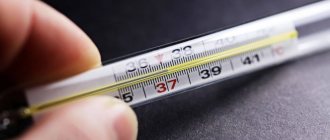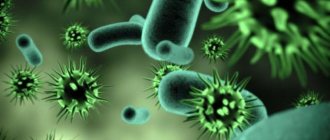Normal temperature is simply necessary for the effective functioning of all organs and tissues of the body, and any deviations - both upward and downward - worsen the functioning of the body and very often indicate the occurrence of various diseases.
Therefore, the question of what to do with increased or decreased body temperature remains relevant for a large number of people. The logical consequence is the need for a detailed and detailed consideration of the answer to it.
Body temperature in adults
The ability to maintain body temperature at an optimal level for normal life is called thermoregulation. It is a complex of processes occurring in the body that cannot be tied to any single center. Their course is influenced by many factors, including age, personal characteristics of a particular person, time of day, external influences, level of physical or mental stress, etc.
What is the normal temperature
For a long time, a temperature of 36.6°C was considered normal. This figure was obtained as a result of large-scale research conducted in the mid-19th century.
Current scientific data looks a little different. Firstly, today's research shows the average temperature to be 36.2 degrees. Secondly, scientists consider normal not a single figure, but a range, ranging from 35.5 to 37.6°C.
Source: dom-prestarelyh.ru
Such a wide range of indicators clearly demonstrates the importance of both the individual characteristics of the body and the significant level of possible fluctuations in human body temperature during the day.
The difference in results when measuring temperature in different places - the armpit, under the tongue or in the rectum, which is approximately a degree and a half, deserves special mention.
Temperature during pregnancy
One of the factors that strongly influences temperature is hormonal activity. The consequence of this relationship is the frequent fever experienced by pregnant women. For a similar reason, you should not be surprised by temperature fluctuations during menstruation or menopause.
This does not mean at all that a prolonged, albeit slight, increase in temperature in a pregnant woman is not a reason to consult a doctor. In such a situation, it is extremely important to get tested and undergo a comprehensive examination, which will rule out the presence of infections or other diseases.
For example, an increase in temperature during pregnancy is often a consequence of ordinary seasonal acute respiratory viral infections. In this case, it is not necessary and very wrong to self-medicate. You need to make an appointment with a doctor and receive qualified medical care.
Fever
The thermoregulation system gradually improves during the first year of life. Therefore, for infants, especially within three months from the moment of birth, significant temperature fluctuations are characteristic. An important difference between a child’s body and an adult’s body is the more serious influence on temperature indicators of a number of factors, including:
- ambient temperature;
- characteristics of clothing;
- emotional state, laughter and crying;
- eating, including breastfeeding;
- swimming in too warm water, etc.
Another difference from an adult is the increased danger of high temperatures - from 38 degrees. It leads to rapid dehydration and worsening health conditions. A manifestation of this, for example, is febrile convulsions and short-term fainting in children under 5 years of age when the temperature rises to 38-39°C.
Symptoms of fever
In general, the temperature is considered elevated, starting from 36.9-37 degrees. It is one of the most common symptoms of many diseases - from infectious to inflammatory.
In addition to measuring with a thermometer, as the most obvious way to determine elevated temperature, its symptoms include:
- weakness, pain, fatigue;
- dry lips and skin;
- loss or deterioration of appetite;
- chills;
- sweating;
- general discomfort.
Fever
Fever refers to an increase in temperature, which becomes the human body’s reaction to an infection, in other words, to a disease. Usually there are two types:
- Red or pink . Symptoms include redness of the skin (especially strong on the face), a bright blush. Such manifestations are the result of dilation of superficial blood vessels to improve heat transfer. At the same time, sweating increases, which also helps to reduce the temperature of the skin and underlying tissues. The launch of such processes indicates the body’s effective fight against the disease.
- White. A more dangerous type of fever. Occurs as a result of failures in thermoregulation. Symptoms include whitened skin (feet and hands become especially cold), chills, a sharp and severe deterioration in health - even fainting. All this is accompanied by high temperature, including in vital internal organs, which affects their functioning.
Causes of elevated temperature
An increase in temperature in most cases occurs as a result of the production of pyrogens by the human immune system, which affect thermoregulation. Such processes are activated in the following cases:
- infections in the form of protozoa, bacteria, viruses, etc.;
- injuries and burns that lead to a general fever or local increase in temperature;
- allergic reactions;
- states of shock.
Today, artificial pyrogens have been developed and are actively used as medicines. They are used to increase temperature to treat various diseases.
Low-grade fever
Low-grade fever is a temperature that is slightly higher than normal, but does not reach high. For an adult, we are usually talking about a range between 37 and 38 degrees. It is important to understand that elevated temperature is an indicator of the body's fight against infection. Therefore, you should not perceive it only negatively and immediately begin measures to reduce it.
On the contrary, a deviation from normal values of one or even one and a half degrees rarely carries serious risks for the body and does not cause cell death or deformation of protein molecules. Often, an increase in temperature to 37-37.5°C is a consequence of stress or poor nutrition, caused by hot weather or other external factors.
On the other hand, a long stay - for two to three weeks - in such a state often becomes a symptom of the disease. Therefore, you should not rush and “bring down” the temperature. It is much more correct to visit a doctor, undergo the examinations prescribed by him and follow further recommendations of a specialist.
Reduced temperature
Another name for low temperature is hypothermia. It is less common than elevated blood pressure, but it also often becomes an indicator of significant health problems. For an adult, a value of less than 35.5 degrees is considered low, for an elderly person – below 35°C.
More severe falls are characterized by the following consequences:
- 32-32.2°C – falling into a stupor, noticeable lethargy;
- 29-30°C – fainting, loss of consciousness;
- Below 26-27°C there is a significant probability of death.
General symptoms of low temperature:
- malaise, some lethargy;
- rapid fatigue and weakness;
- irritability;
- numbness of fingers and toes, coldness in the extremities;
- disturbance of thought processes, loss of mental clarity;
- feeling of freezing, periodic or constant trembling.
The main reasons for a decrease in body temperature are:
- hypothermia, which results in metabolic slowdown, frostbite of the hands or feet, decreased immunity and other unpleasant consequences;
- problems in the functioning of the body’s endocrine system and insufficient production of hormones;
- weak immunity associated with previous diseases or the consequences of complex treatment, such as radiation therapy.
Taking medications
The temperature may also increase while taking medications. You should read the instructions; usually the side effects indicate the possibility of increasing it. Some drugs can also inhibit beneficial microflora. This is especially true for medications that have an effect on the nerves.
Other reasons
Other reasons are as follows:
- Intestinal disorders.
- Malfunctions of the endocrine system.
- Autoimmune processes (connective tissue diseases).
- Tumors.
Diseases at elevated temperatures
Fever is a serious symptom that requires professional evaluation. Therefore, there is no need to self-medicate; it is much better to consult a doctor. This is the first and main recommendation in such a situation. It makes sense to consider the most common types of diseases for each type of elevated temperature in more detail.
Diseases with a temperature of 37-38°C
- ARVI.
- Tuberculosis.
- Colitis and ulcers.
- Toxoplasmosis.
- Viral type hepatitis.
- Acute stage of herpes.
- Chronic respiratory diseases, including bronchitis, tonsillitis, bronchial asthma.
- Myocarditis, pyelonephritis, endocarditis and other chronic diseases of internal organs at the acute stage.
Diseases with a temperature of 39-40°C
- Pneumonia.
- Angina.
- Sepsis.
- Diseases of the gastrointestinal tract, including cholera, dysentery, salmonellosis.
- Numerous infectious diseases - measles, chicken pox, viral type hepatitis (A), influenza, coronavirus infection, encephalitis, meningitis, hemorrhagic fever.
How to lower your temperature
As noted above, it is not always necessary to lower the temperature. The fact is that increasing it is becoming one of the ways to combat infectious diseases.
Positive effects of rising temperatures
Elevated temperature means the launch or activation of several processes in the human body:
- synthesis of interferon, one of the main functions of which is to protect cells from bacteria and viruses;
- production of antibodies that destroy antigens;
- phagocytosis, which triggers the absorption of foreign bodies entering the body by phagocyte cells;
- decreased activity and appetite, which frees up resources and energy to effectively fight the infectious disease;
- deterioration of conditions for the existence of viruses and bacteria not adapted to elevated temperatures.
When to act
The first and main reaction to an increase in temperature is to visit or call a doctor. It makes sense to take independent actions to reduce it in the following cases:
- exceeding 39 degrees;
- a sharp and rapid deterioration in health, including fainting, nausea, diarrhea or dizziness;
- signs of severe dehydration appear;
- presence of neurological diagnoses;
- the presence of chronic vascular or heart diseases, as well as diabetes;
- for children – febrile convulsions (in this case, you need to bring down the fever from 37 degrees).
What do we have to do
Reducing the temperature involves several sequential actions:
- Call a doctor.
- Bed rest.
- Periodically ventilate the room where the patient is located in order to keep the air a little cool and fresh.
- Drink plenty of fluids – constantly, but little by little. Optimal drinks are black tea with lemon, green tea, fruit drinks, diluted juices, compotes.
- Taking antipyretics is best as prescribed by a doctor. The most accessible and effective drugs today are considered to be: paracetamol;
- ibuprofen;
- acetylsalicylic acid;
- nimesil;
- ibuclin;
- rinza, etc.
Any drug should be taken strictly in accordance with the instructions. A mandatory additional condition is purchasing the medicine at a pharmacy and taking into account the requirements regarding the expiration date.
Treatment
It all starts with finding the cause of the condition. After this, the following may be prescribed:
- Antibiotic. If the cause of the temperature is infection, a remedy is selected taking into account the type of pathology. For tuberculosis, several drugs are combined at once.
- Antiviral agent. Helps fight hepatitis and HIV infection. They slow down the proliferation of pathogens and reduce the load on the circulatory system. If the infection is intestinal or respiratory, other drugs are chosen.
- Non-steroidal anti-inflammatory drugs. Help reduce pain and stiffness. Selective inhibitors are usually chosen to reduce gastrointestinal side effects.
- Vitamins. Their goal is to strengthen the body, increase immunity and energize a person.
- Hormonal agents. Needed by women experiencing menopause. Usually, a course of hormone treatment completely eliminates the temperature. Combined contraceptives will help with severe premenstrual syndrome.
- Cytostatics. Used together with combination chemotherapy for cancer.
- Infusion solutions. They are needed if viral and bacterial infections become so severe that they cause intoxication of the body. Prevents cerebral edema.
Body temperature in children
Deviations in temperature indicators - both upward and downward - are especially dangerous for a fragile or not fully formed child’s body. It is important to consider that different temperatures are considered normal for different ages:
- for children under one year old – 37-38 degrees;
- from one to five years – range from 36.6 to 37.5°C;
- adolescence – serious temperature fluctuations caused by activation of the processes of production of sex hormones are acceptable. Therefore, it is impossible to indicate exact values and you should focus on other symptoms of the body’s condition;
In girls, temperature indicators stabilize at values close to adults and equal to 36-37°C at 13-14 years of age. For boys, this process can drag on until they are 17-18 years old.
Source: Yandex.Zen
Prevention
If you don't want to deal with daily fluctuations in body temperature, you need to strengthen your immune system. To do this, you should adhere to the following preventive rules:
- You should lead a correct lifestyle.
- Every day you need to set aside a small amount of time for physical exercise.
- It is necessary to eat properly and balanced. You will have to eliminate all harmful foods from your diet.
- You should also stop drinking alcohol and smoking.
- Throughout the day, it is necessary to consume a sufficient amount of water, which is at least 2 liters per day.
- Experts recommend hardening the body.
- For prevention purposes, you should take vitamin complexes.
- Your daily diet should include fresh vegetables and fruits, as well as other foods that are rich in nutrients and vitamins.
Fluctuations in normal temperature
Possible fluctuations in normal temperature for children are given above. Here it is necessary to note a similar parameter in relation to adults. Its standard values range from 36 to 37 degrees, although most scientists set a wider range - 35.5 to 37.6 ° C. It is he who is considered generally accepted today.
Fluctuations in body temperature in older people deserve special mention. For this category, the optimal value of the parameter under consideration is within 36.3 degrees. An increase in temperature to 37°C or higher becomes a serious symptom and often indicates a febrile state of the patient.
How to measure temperature correctly
Various methods are used to measure the temperature of the human body. It is important to note that depending on the chosen method, the results obtained vary somewhat. Most often, classification is carried out according to the place where the thermometer is applied or placed:
- Armpit (axillary method). The simplest and most often used in everyday life. The requirement is the absence of moisture in the armpit and a tight fit of the thermometer to the body. Measurement duration is 7-10 minutes. Normal values for an adult using this measurement method are 36.2-37°C.
- Rectum (rectally). The method is especially often used in relation to children, as it is simple, safe and quick (it only takes a minute and a half). Standard values are approximately a degree higher than for axillary ones, and amount to 36.8-37.6°C.
- Mouth or under the tongue (oral or sublingual). A popular method of measuring temperature in Europe, much less commonly used in Russia. The duration of the measurement is from one minute to five. Normal values for an adult are close to rectal measurements, although slightly lower - 36.6-37.4°C.
- Ear canal . The method is used for children, but requires a special thermometer designed for non-contact measurements. Given the relative rarity of such devices, it is rarely practiced. Effective for diagnosing otitis, which is characterized by inflammatory processes that sharply increase the temperature in the ear canal. Therefore, the values of the latter can reach serious figures.
- Vagina . Specific measurement method. It is used to determine a woman’s basal (that is, lowest) body temperature. Measurements are taken after prolonged rest or sleep and are used to detect inflammation in the pelvic area or the onset of ovulation.
Diagnostics
A patient with thermoregulation disorders is examined by a general practitioner or emergency physician (in case of critical hypothermia). The scope of diagnostic measures depends on the patient’s condition and the degree of temperature decrease. At values above 32°C, advanced laboratory and instrumental studies can be performed to identify the cause of hypothermia; at lower values, they are limited to basic methods. The most informative:
- Physical examination
. First of all, to detect the cause of a person’s low body temperature, thermometry is performed. Temperature is most often measured in the rectum; an esophageal probe is used to obtain accurate information about the internal temperature. To assess consciousness, the integrity of the pupillary and pain reflexes is checked. - Blood tests
. The basic checklist includes measuring glucose, red blood cells and hemoglobin levels. A biochemical blood test can reveal high levels of nitrogen and urea, laboratory symptoms of liver disease. To diagnose anemia, the amount of free iron, ferritin and transferrin is determined. - Hormonal profile
. To exclude pathologies of the thyroid gland, the content of thyroxine and free T3, thyroid-stimulating hormones of the pituitary gland are taken into account. You also need to examine the amount of adrenal hormones and catecholamines. To confirm Addison's disease, an ACTH stimulation test and information about the levels of essential electrolytes are required. - Electrographic methods
. An ECG is recommended for all patients, which allows detecting pathognomonic signs - Osborne wave, prolongation of the PQ and QT intervals. To assess the functional activity of the brain, an EEG is prescribed. In a hospital setting, electromyography and electroneurography of peripheral nerve trunks are sometimes performed. - X-ray imaging
. A CT scan of the brain is the first thing to do to rule out central causes of low body temperature. The images may reveal mass formations or possible swelling of the hypothalamic region. Scintigraphy of the thyroid gland with iodine isotopes helps to study the structure of the organ in more detail.
Types of thermometers
On the Russian pharmacy market you can purchase different types of thermometers. Three of them are the most popular:
- Mercury or maximum. Budget-friendly and easy to use. The bonus is high measurement accuracy. Widely used both at home and in various medical institutions, usually axillary. Two significant disadvantages are fragility and serious measurement time. Another disadvantage is that mercury vapor is poisonous, and therefore requires very careful handling of the thermometer.
- Electronic or digital . It appeared relatively recently, but quickly became very popular. The reasons are the speed of measurements (from half to one and a half minutes), several varieties and a very reasonable price. A bonus is the ability to use different measurement methods. The only drawback is a certain scatter of values, which demonstrates the not very high accuracy of the device.
- Infrared. An innovative and expensive thermometer. Measures temperature in a non-contact manner. The time required for measurement is only 2-5 seconds. It is not used axillarily, orally or rectally, and therefore has a limited area of use.
FAQ
What is meant by elevated temperature?
By elevated we mean a temperature that is higher than the standard values for a person of a certain age. A similar definition is given for low temperature, but in this case we are talking about a decrease in value compared to normal.
What temperature is considered normal?
For an adult, a temperature range of 35.5 to 37.6°C is considered normal. It is important to remember that for a particular person it can vary significantly depending on the individual characteristics of his body.
What should you do if the temperature rises?
The first and most important rule is to call or visit a doctor. Next, you should act on his recommendations.
Is high or low temperature dangerous?
Quite often, deviations from the normative values indicate the occurrence of diseases, often serious ones. Especially if we are talking about a long process or a strong increase/decrease in temperature.
What means are used to reduce high fever?
Medicines should be used as prescribed by a doctor. In emergency cases, it makes sense to use paracetamol, ibuprofen, acetylsalicylic acid and other similar medications that are available and well known.
Conclusion
- Body temperature is one of the key indicators of the state of the human body.
- The normal value of this parameter for an adult is considered to be 35.5-37.6°C.
- For children, the standard temperature values are slightly higher, for older people – slightly lower.
- An increase or decrease in temperature often becomes a symptom of disease. Therefore, it is best to consult a doctor.
- It is not always necessary to lower the temperature - if there is a serious deterioration in health or the indicators reach 39 degrees or higher.
Nervous and physical exhaustion
High physical activity, prolonged stress, lack of sleep, poor diet and strict diets often lead to a deficiency of the body’s energy resources. As a result: metabolism slows down, blood circulation slows down and the temperature drops below normal by 1-2 degrees. The pathological condition is accompanied by significant weight loss, apathy, weakness, fatigue, depressed mood or increased nervous excitability. There may be frequent headaches and decreased mental abilities. The person becomes distracted and inhibited. There is a weakened immune system and hypovitaminosis.
With physical and nervous exhaustion, body temperature steadily decreases to +35–35.5°C. The condition is accompanied by chills even in warm weather. This pathology is usually not life-threatening, but it is an alarming sign that requires urgent lifestyle changes.










